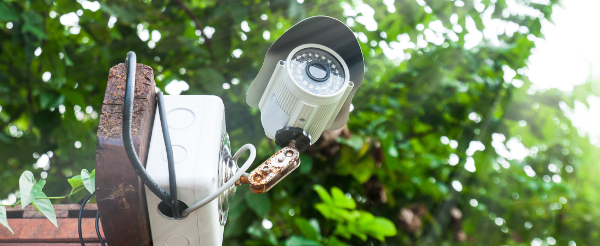
ADT’s Pulse
The home security giant’s flagship service is called ADT Pulse, which offers home automation controls through its smartphone apps.
Chief among these is the ADT Pulse Voice app, which can control lights, thermostats, door locks and other appliances by using voice commands.
There’s also the Canopy app that lets you share the locations and whereabouts of loved ones on the go, and motion sensors that provide real-time information on the security in the home.
The company, founded in 1874, also partnered with McAfee earlier this year to offer users digital security for their data and devices, while a deal with Ford put ADT’s voice controls into vehicles equipped with Ford Sync Applink.
In May, ADT also invested $25m into San Francisco-based startup Life360 to develop co-branded mmobile security applications.
Comcast’s Xfinity
Home automation is a growing area for Comcast and the company has been offering security, energy management, remote lighting and thermostat control through its Xfinity Home package since 2012.
The company, which has more than three million Xfinity Wi-Fi hotspots in the US, continues to improve the service. Last year, it launched Xfinity Home Control, which allows users to remotely adjust smart appliances without the professional security monitoring that comes with other Xfinity Home services.
For a monthly fee, customers can get real-time notifications when doors and windows open or close, watch live streaming videos of their home via wireless cameras and manage home devices, including lights and thermostats, remotely or by using automated schedules.
However, the services were recently under fire after the company’s home security platform failed to detect intruders who broke into a couple’s home in Washington. When the security system failed, they broke into the basement and tortured their 18-year-old son.
Apple’s Homekit
In June, the iPhone maker introduced HomeKit, its smart home platform for integrating devices through iOS, which allows users to securely control appliances from their iPhone or iPad.
Although the system is still in its earliest days, the company is currently gathering an ecosystem of devices, including Philips’s remote-controlled Hue light bulbs, Belkin’s WeMo switch, and the iBaby monitor, to integrate with it.
Apple Insider this week reported that the latest beta software for Apple TV could become the HomeKit hub for smart devices, which allows users to control connected HomeKit devices while out of the house.
Samsung
Introduced at the Consumer Electronics Show (CES) 2014, the system uses a single app that home owners can access to control Samsung-branded appliances using their smartphone, TV remote control, tablets or smartwatches.
For example, voice commands could be used to turn off lights or a television set, and in return they could send alerts to owners if they need servicing.
The system also connects to cameras in fridges, a vacuum cleaner and dishwashers among other devices, allowing users to keep an eye on their homes when they’re away. For example, users can automatically control the washing machine to have their clothes ready when they get home while controlling other devices.
Samsung has promised that all data that is transmitted by the app is encrypted for increased security. This ensures that the people can enjoy the service safe in the knowledge their data remains private, according to the firm.
Last month, the smartphone giant said it was planning to open up its smart home system to make it work with third-party technology after acquiring SmartThings, which provides an open smart home platform.
In July, the company also became part of Thread, a consortium of companies aiming to build a low-power mesh network as an alternative to Wi-Fi and Bluetooth.
LG’s HomeChat
The company’s HomeChat system relies on Natural Language Processing (NLP) that allows owners of LG appliances to chat with their washing machines, fridges or vacuum cleaners using natural-language commands.
For example, users can text their washing machine to ask "What are you doing?" and get updates from their fridge to remind them to buy food for the evening.
You could also tell the system "I’m going on holiday next week" and it will know to turn on security cameras or switch on some lights at night to make your house more secure.
Users can also receive real-time status updates from appliances wherever they are and use their mobile phone to view what is going on within their homes.
So far, the system works through Line, a free mobile messenger app, but the firm says it’s planning to launch the service on WhatsApp, China’s WeChat and Korean messaging service Kakao Talk as well.
It also works on Android, BlackBerry, iOS, Nokia and Windows Phone devices as well as OS X and Windows computers and is expected to be released in America later this year.
In the summer, the company said that it is working on a new version of its WebOS-based operating system for Smart TVs after reporting that it had sold one million WebOS-based TV sets.
Google & Nest
Google and Nest Labs are also on a quest to become a hub for home security after the search giant paid $3.2bn for the maker of smart smoke alarms and thermostats.
Under Google’s umbrella, Nest is bolstering its collection of smart products and turning the Nest Learning Thermostat into the hub of smart homes.
For example, with the "Works with Nest" developer programme, announced in June 2014, gadgets, cars and universal remotes will all work with the Thermostat.
In the summer, Nest also bought video monitoring service DropCam for $555m to learn how people behave in their homes, for instance by reportedly tracking how doors are open and shut.
Lowe’s Iris
The home improvement retailer has been offering its home management system called Iris and other products for the connected home since 2012.
All of the appliances connect via AlertMe’s cloud-based home management system, and customers can digitally manage their home appliances and devices via a computer or mobile app over Wi-Fi, Zigbee and Z-Wave.
The system is quite flexible and users can use it to track energy costs and appliances such as lights, locks, sprinklers, blinds and more.
Products range from a Safe and Secure start-up kit that includes a hub, motion and contact sensors and a keypad; a Comfort and Control kit that includes a smart thermostat and smart plug; and a more expensive Smart Kit that includes all of the above plus a Wi-Fi range extender.
Insteon
The home automation firm’s services and hardware include the Insteon Hub and the Insteon Starter Kit, the Insteon LED Bulb, the Insteon Thermostat and the Insteon Leak Sensor among other smart appliances.
Microsoft started selling its devices back in the summer and last month brought voice control to its home automation products.
The Insteon app for Windows Phone 8.1 now lets users use Microsoft’s Cortana voice recognition technology to control their home. Combining the Insteon home automation hub and Cortana, users can control more than 200 connected devices.






